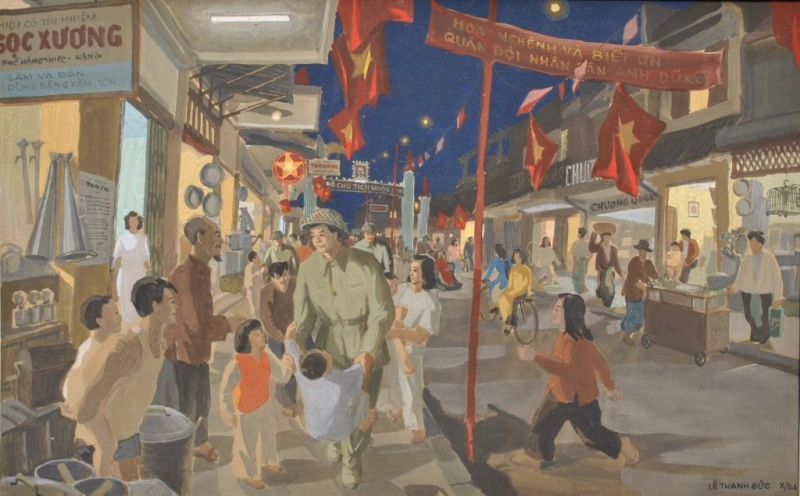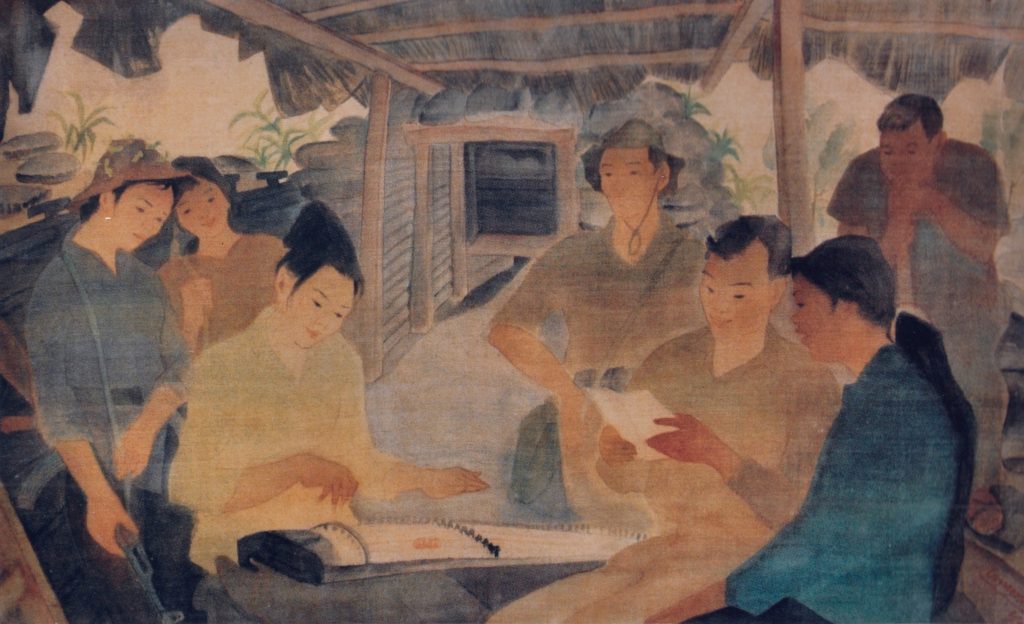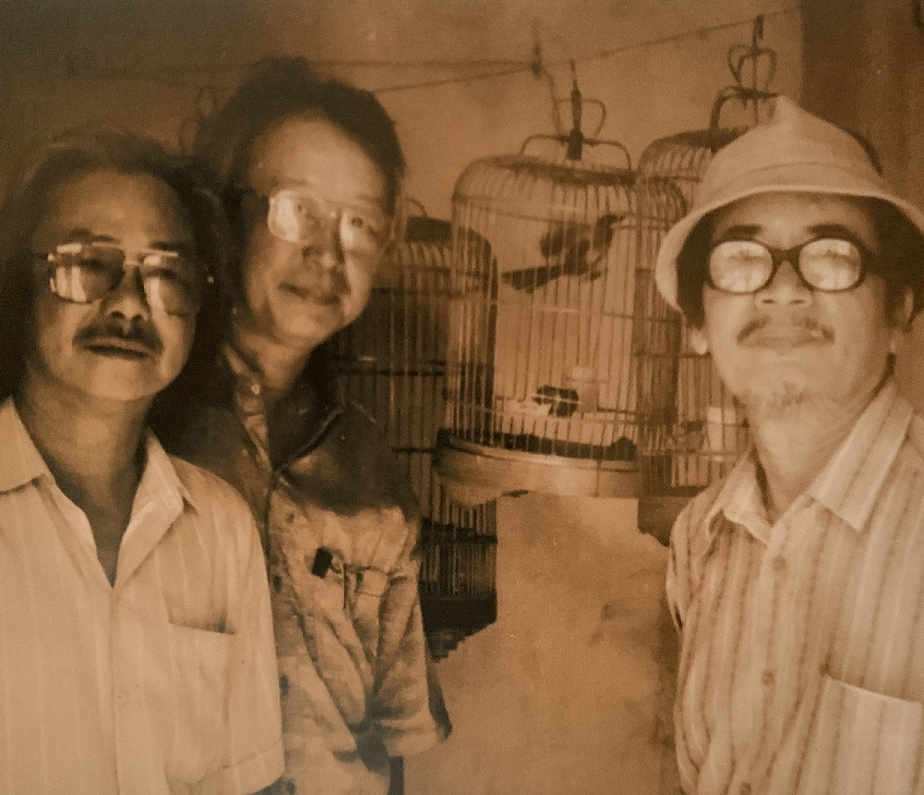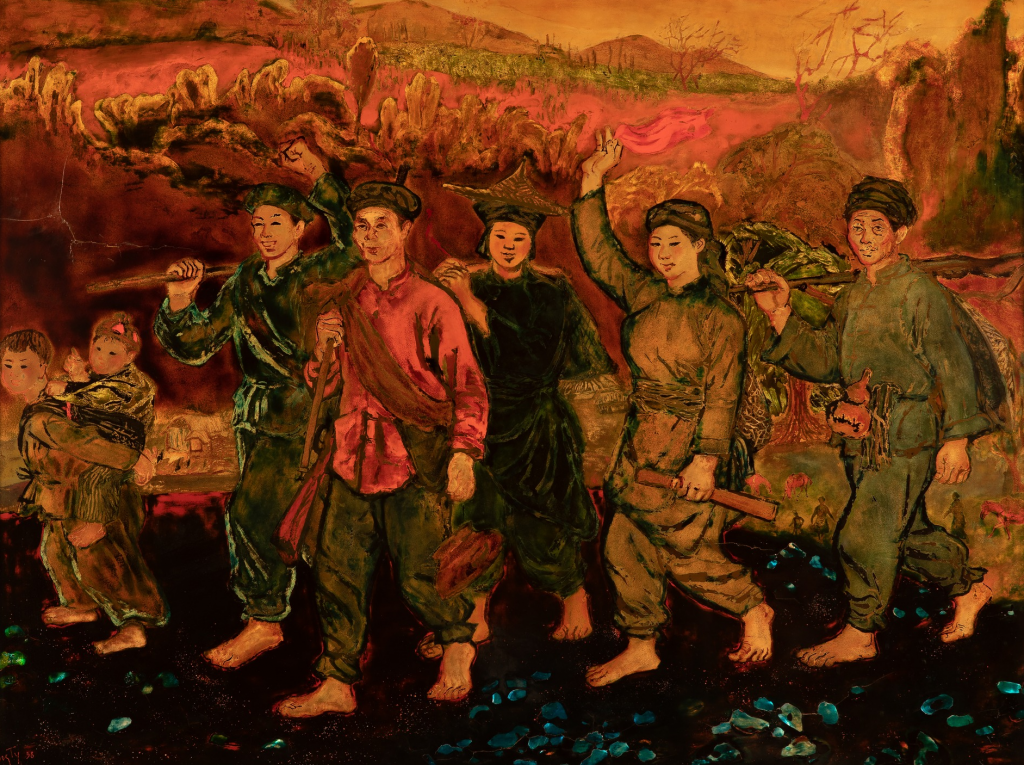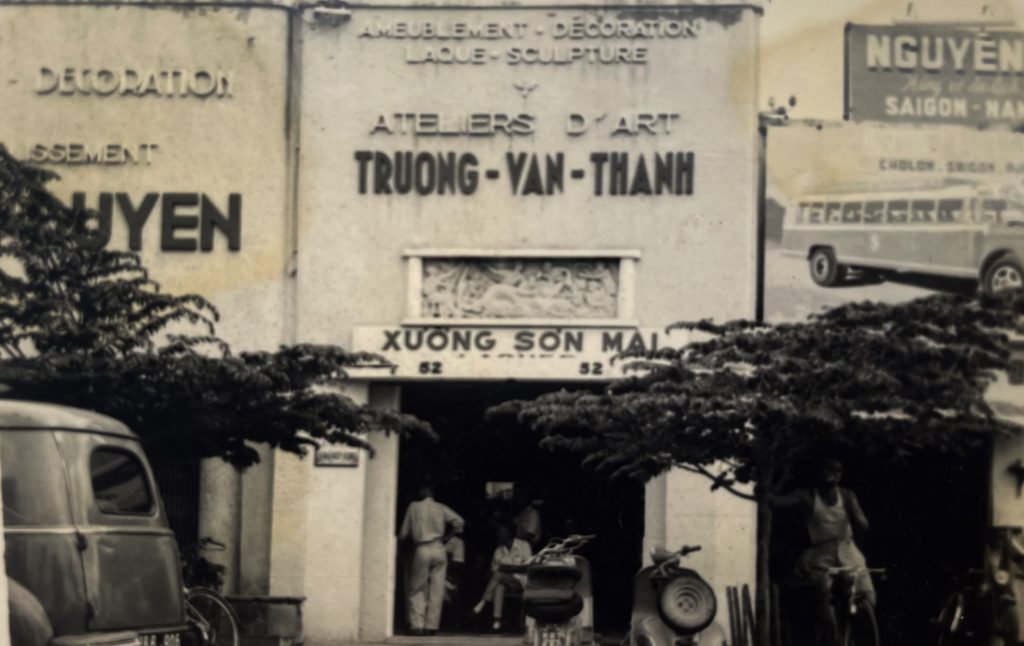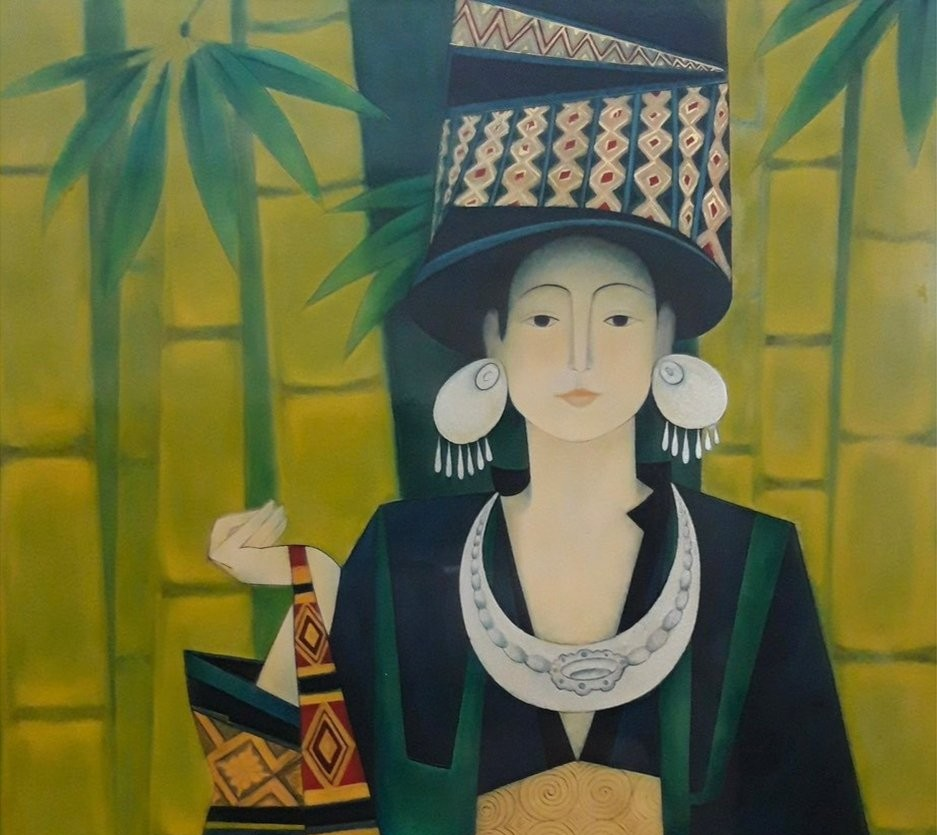An interview published in Fine Arts Magazine exactly 20 years ago, in the 20th anniversary issue of Fine Arts Magazine (1977-1997)
Editor’s note: On May 20, 1997, artist Pham Tang left Vietnam and returned to Paris, where he lived and worked, on a night flight of French Airlines, which took off at Noi Bai at 6:30 pm.
After “one month and seventeen days” (exactly according to his counting) — Pham Tang ended his pilgrimage to regain his memory of “banyan trees, wells, pond banks”, about “old people, old friends” more than half a century ago, about “times deep in the past”… A journey full of contemplation of the 73-year-old artist with silver hair.
At his grandson’s house (lane 2, Ngoc Ha slope, Hanoi), on the morning of May 14, artist Pham Tang gave journalist Quang Viet — a reporter of Today’s Fine Arts Magazine — a friendly close exchange around the “hot issues” of Vietnamese painting.
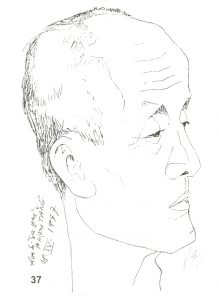
Trần Tuy – Ký họa Phạm Tăng. 1997 Lời trong sách: Họa sĩ Phạm Tăng. Là họa sĩ Việt Kiều xa quê lâu năm. Tranh sơn dầu của ông thường diễn tả sự chuyển động không cùng của vũ trụ mênh mông. Tôi vẽ ông khi ông đến Hội nhân đợt về thăm đất nước
– Pham Tang (PT): Westerners always plan, at least a few years, for their art programs (he immediately started). I don’t know how it is in Vietnam, but Western “galerie” are “picky” about artists. And vice versa, the artists also “filter” the “galerie”.
– Quang Viet (QV): What does this mean in the upcoming story, sir?
– PT: It is a quote for an opinion of mine. That the number of artists from Vietnam to exhibit paintings in the West more than 10 years ago, had not occupied good positions, as in France, such as Beaubourg or Petit Palais.
However, there are still certain “conceited people”, of someone, which not only a few people know. It is “conceit and arrogance” that lacks any factual basis.
– QV: What about in Vietnam, during your recent visit?
– PT: I went to see paintings at some “salons” and “galerie” in Hanoi. Most of the paintings are made quickly to sell, cheap, for “tourists”. Also earn well, looks like that. You should sympathize, because we have to live (laughs).
– QV: Is there no problem, sir?
– PT: Why not? Veer? Open? Veer, open how? Well!
Remember: there is “information” and there is also “déformation”.
– QV: And what information did you notice?
– PT: In France, I always follow the situation in homeland. One time, I saw a photo of a Vietnamese “toile” with the back of Karl Marx clearly visible. It’s been a long time, so I don’t remember what magazine the photo was in.
There are also people who buy a lot of “petit” (small) paintings of Bui Xuan Phai, which are cheap, mainly painting lamps and cigarettes, and then choose to print them into books to promote the so-called “liberation from the spirit of cubism.”
– QV: So your personal attitude?
– PT: I should have written something. But, write for whom? And who posted? (Smoking tobacco).
– QV: Please come back a bit with the word “must live”.
– PT: It’s like this (laughs), old people don’t usually dare to devalue themselves. Thought it was conservative, but no!
They have serious capital, not babblers. They are in a position where they cannot be arbitrary (shrugs).
Young people face many difficulties of their own. Still have to “plow”. Art is to roll around, cannot do it carelessly.
– QV: What do you think is the difference between “old” and “young”?
– PT: … The point is to encourage each other. Is building for the future of art.
It is impossible to say which is “old” and which is “young”!
– QV: Then where is the general assessment of an artist?
– PT: Don’t look at “this degree and that”, that’s no different from “ID card” to enter the profession.
The “artiste” has to face his own generation, his predecessors, and his followers.
The pinnacle of art has countless paths to reach. Which way to choose? Well!
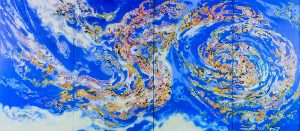
Pham Tang — ‘A feature of “Heaven and Earth”. 1978. Mix mediums
– QV: What does “Well!” mean, sir?
– PT: We Vietnamese people used to be influenced by Chinese art, then came to France… Strictly speaking, those are two “chains”. To put it mildly, two borrowed “glasses”. Try taking them all out and see if it wobbles?!
Vietnamese painting has to find its own “boxing line”. Why are we still wondering whether to follow China or follow the West? There are still so many “mats” to sit there!
– QV: In your own view, what has been achieved of Vietnamese painting?
– PT: The Vietnamese painting industry has done a good job of fighting to save the country, serving the “workers, farmers, soldiers”… The painters participating in the resistance war all painted “the hand with five fingers, the head only wears a hat”…
I remember a time when Bui Xuan Phai stayed at my house. He couldn’t draw “memoire”, so he had to ask “Pham Tang” to help two “bone and flesh” soldiers stand for models.
At that time, I met Bui Xuan Phai in Cho Dai, intending to do a joint exhibition on Yen Mo land, Ninh Binh, unfortunately, I couldn’t do it.
After 1975, Vietnamese painting also planted some “new flowers”. We have learned and are trying to go beyond the “rational mind” of the West to gradually return to our Eastern origins. Or a combination of both, but must be skillful.
It is not allowed to forget the achievements of mediums – materials as well as the achievements of modern science.
– QV: Can you tell us about the general impression of Vietnamese painting at the right time?
– PT: Just like our traffic (using two hands to express collision).
– QV: Is there an effective solution, sir?
– PT: If in economics, someone has to stand out and “squeeze their heads”, then art in the spiritual field is much more difficult. It is necessary to arrange painting in a proper way. There must be “red light green light” right?
– QV: A more specific initiative of yours?
– PT: I’m willing to be “an unpaid consultant”, of course, in the fine arts. When I returned home, musician Tran Hoan introduced me to the Hanoi People’s Committee, hoping to discuss an art project for the city. On time, people came to pick up quite attentive. Their cars and offices are truly luxurious. But what surprised me the most was that at the very beginning of the meeting, an official said that they could only receive me for about 20 minutes!!! (Smoking tobacco)
– QV: Sir, this incident can be considered as an ellipsis to end common problems. Now, can you tell us a little bit about “Painter Pham Tang”?
– PT: I have exhibited in Germany, Switzerland, Belgium, the Netherlands and from North to South America. In France, the Galerie de France, Paris, of the greatest kind, they invited me, but so far I have not been able to reciprocate their enthusiasm. This galerie used to show Bernard Buffet, Hartung, Zao Wou-ki…
The critic Giolio Carlo Argan, Chairman of the International Association of Art Critics (AICA) introduced and encouraged my works. Giolio is also the mayor of Rome, a member of the Italian communist party. It must be affirmed: no one can “buy” a person like him.
– QV: What about poetry?
– PT: I wrote poetry, initially to practice my mother tongue. It’s a bit like the past decades, I still smoke pipe regularly, to visualize and remember “banyan trees, wells, pond banks” (laugh).
– QV: If possible, may I ask why did you decide to live abroad?
PT: The answer lies in stanza 4 of my poem Clouds of Five Colors. As for my “purpose – ambition” is placed in stanza 6 (after saying that, he searched for the book Pham Tang Poetry, Literature Publishing House, 1994, pages 40 and 41, and read the whole poem as well).
– QV: What are some of your profound memories of the “old days” in your homeland of Vietnam?
– PT: First of all, I would like to emphasize one fact: That few places had as many art exhibitions as Zone III in the early resistance against France period. The Nam Dinh Resistance Committee asked me to open an exhibition to sell paintings, raising money to support the Southern Resistance. I went back and forth in Hanoi seeking for paintings of Hoang Tich Chu, Nguyen Tien Chung… Also looking for Nguyen Sang and Diep Minh Chau to draw portraits, but they were busy. We also hold auctions…
To this day, I still can’t forget the time when I received a prize of 2,000 VND for a poster painted on the wall by a strange cadre officer who I did not know or even met, passing and voluntarily to give the prize to me. At that time, poet Luu Quyen (who used to have activities at the same party level as Nguyen Luong Bang and Tran Huy Lieu in Son La prison) was the director of information and propaganda. He was a wonderful communist that I knew and respected greatly. When Luu Quyen died, I wrote a poem to cry for him!
– QV: During this visit, did you go to Ho Chi Minh City?
– PT: Before going abroad, Saigon was where I lived for a few years. I also had a lot of “happy and sad” there, but have no intention of returning.
– QV: About your relationship with painter Nguyen Gia Tri?
– PT: In the 1950s, I was the one helping Nguyen Gia Tri to rent the house that his family still in today. At that time, Mr. Tri was unmarried and lived in poverty. Later, when I was in Rome, he and I often wrote letters to each other.
– QV: What about the things that have not stopped circulating about Nguyen Gia Tri so far?
– PT: At the same time when I was in Rome to meet Mr. Mai Tho Truyen — Secretary of State for Culture, I noticed the “former government” about Nguyen Gia Tri’s talent for painting.
Because of that, Mr. Tri has negotiated with Mr. Nguyen Luong Vien a contract to guarantee the creating of large-dimension lacquer paintings, costing several million dong. After all, the government intends to send these paintings to attend the Osaka Crafts Fair, Japan.
Mr. Tri was definitely not content to display his work as a item of crafts.
Disagreements arise, of course.
Even I myself had to sit in the cell of Catinat in 1956-1957 on the charge of “undermining public order and peace for the benefit of the communists”.
There are many stories around Nguyen Gia Tri, now that Mr. Tri was gone, let them rest in peace with him (the artist ends).
By the way, remember to find me the old award presenter.
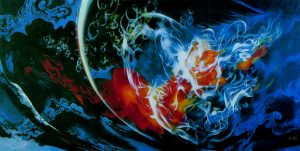
Pham Tang — ‘Universe’ 1975. Mix mediums
Painter Pham Tang was born in 1924 in Yen Mo, Ninh Binh. Studied painting and architecture at Indochina Fine Arts College (Hanoi, 1943-1945).
Fifteen years later, wandering to Europe. Dived into all the subjects taught at the Institute of Roman Fine Arts (Accademia di belle arti di Roma). Graduated in painting and decoration, then studied sculpture and theatrical art.
In 1967 won the first prize of UNESCO for fine arts. Currently living and working in Paris.
By art critic Quang Viet
[Today’s Fine Art Magazine, No. 15 (7) 1997. 20th Anniversary Issue of Fine Arts Magazine]


